#LoRa wireless gateway
Explore tagged Tumblr posts
Text
LoRa GSM RJ45 System Connect Multiple Wireless Node Greenhouse Planting
LoRa gateway S281 uses LoRa RF communication technology to transmit equipment data from multiple points in a discrete distribution to the gateway through wireless LoRa nodes, and the LoRa gateway processes the data and transmits it to the server through Ethernet or 4G network, thus realizing remote data acquisition and monitoring. LoRa gateway supports a variety of wireless LoRa nodes, including temperature&humidity, weather, soil, gas, RS485 to wireless module nodes. Support access to the cloud, can realize history record query, high and low temperature over limit abnormal alarm, support voice, WeChat, SMS, APP, WEB monitoring platform, email and other ways to alarm. Widely used in heating, greenhouse planting, breeding, workshop, warehouse, fresh, flow, liquid level, mine and other industries.
Support 50 wireless temperature&humidity, relay, digital input, soil, weather and other types nodes;
Support 50 RS485 serial wireless module nodes;
Monitoring radius up to 2KM;
Support 10 user numbers for receiving specific SMS alarm messages for device daily reports, dropouts, serial data overruns, and abnormal triggers;
Real-time monitoring of terminal battery power to ensure that device data is not dropped;
Using local configuration software, remote SMS and APP to set parameters, easy to operate and use.





0 notes
Text
Top Hart to Modbus Gateway Suppliers for Seamless Integration
Looking for reliable Hart to Modbus Gateway suppliers? We offer high-performance solutions for industrial automation and process control systems. Enhance your data communication with our plug-and-play gateways that support real-time monitoring and efficient system integration.

0 notes
Text
8 Channel Indoor LoRaWAN Gateway | SX1302 LoRa Gateway

The Lansitec Indoor LoRaWAN Gateway is designed for easy indoor deployment, featuring built-in Ethernet, optional LTE uplink, and 2.4 GHz Wi-Fi for quick AP-based configuration. Powered by Semtechu2019s SX1302 chipset and supporting LoRaWAN V1.0.3, this gateway offers a scalable solution for small to medium-sized IoT applications. With OpenWRT software, built-in network server, and PoE compatibility, it simplifies installation and reduces both hardware and operational costs.
For More:
#commercial LoRaWAN Gateway#indoor Lorawan gateway#8 channel indoor lorawan gateway#Sensor integration#SX1302 LoRa Gateway#iot#lansitec#lora#technology#lorawan#bluetooth#wireless#gps
0 notes
Text

Differences Between Noise, Phase Noise, SNR, and Noise Figure in a LoRa Module's Wireless Communication
In wireless communication using a LoRa module, noise, phase noise, signal-to-noise ratio (SNR), and noise figure are crucial concepts used to describe signal and noise characteristics. Their differences are as follows:
1.Noise: In a LoRa module, wireless communication noise refers to the random disturbances present in signals. It arises from the irregular thermal oscillations caused by the Brownian motion of electrons. Multiple sources, such as electronic components, thermal noise, and electromagnetic interference, contribute to this noise. This noise can reduce the signal's quality and reliability.
2.Phase Noise: This denotes the module's random phase signal variations. It disturbs the phase of a sine wave signal, leading to the broadening of the signal spectrum bandwidth. Oscillators or clock systems usually introduce phase noise, which significantly impacts the performance and spectral efficiency of the wireless communication system of a LoRa module.
3.Signal-to-Noise Ratio (SNR): SNR measures the ratio between the average power of a signal and the average power of noise. It's an essential indicator of signal quality. A higher SNR indicates a stronger signal with less noise, which is beneficial for enhancing the reliability and performance of the wireless communication system in a LoRa module.
4.Noise Figure: In wireless transmission using a LoRa module, the noise figure indicates the SNR loss between input and output. It gauges the additional noise power introduced once the input signal goes through the module. A lower noise figure suggests better performance in the module's wireless communication, with lesser noise power introduction.
In summary, in the wireless communication of a LoRa module, noise is the random disturbance in the signal, phase noise is the signal's random phase disturbance with frequency variation, SNR measures the quality of the signal, and the noise figure evaluates the noise power introduced by the module during signal transmission. These concepts offer various perspectives and applications when analyzing the relationship between signals and noise and the module's performance.
For details, please click:https://www.nicerf.com/uart-transceiver-module/lora-rf-module-lora611pro.html
Or click:https://www.alibaba.com/product-detail/Lora611-PRO-4Km-long-range-100mW_1600498427052.html?spm=a2747.manage.0.0.4aca71d2MSoNGh
For consultation, please contact NiceRF (Email: [email protected]).
0 notes
Text
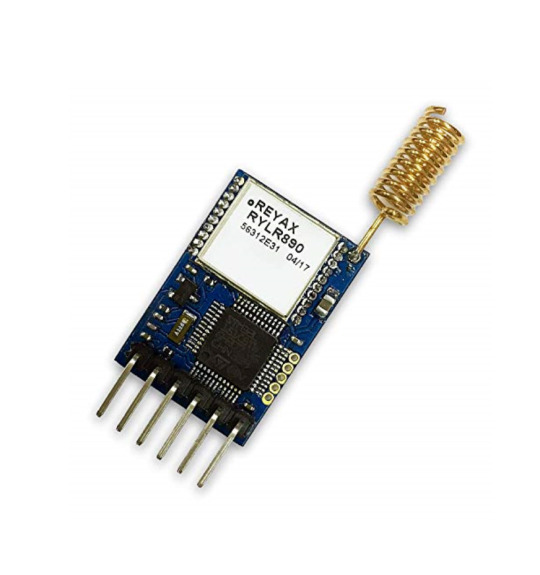
LoRa communication Module
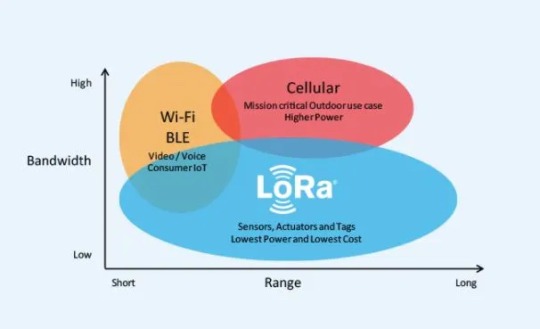
youtube
:
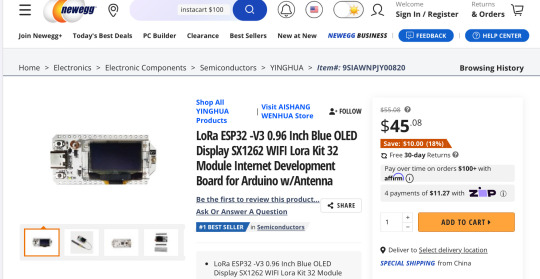
. https://www.newegg.com/p/2A3-00UG-000J9
youtube
.
.
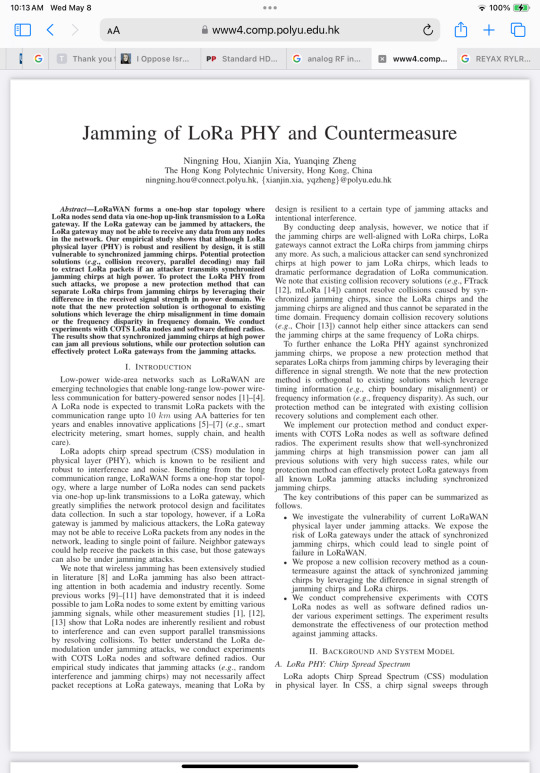
. https://www4.comp.polyu.edu.hk/~csyqzheng/papers/LoRaJamming-INFOCOM21.pdf
2 notes
·
View notes
Text
What is the difference between LoRa and LoRaWAN?
Introduction:
LoRaWAN serves as the communication protocol connecting the LoRa signal (which carries sensor data) to the respective application(s). To simplify, think of LoRa as the radio signal transporting the data, while LoRaWAN acts as the governing framework that dictates how this data travels and communicates within the network.

What is LoRa?
LoRa, short for Long Range, is a wireless technology known for its extended range and energy-efficient characteristics. It operates within unlicensed wireless frequencies, similar to how Wi-Fi utilizes the unregulated 2.4 GHz and 5 GHz bands. The specific frequency employed by LoRa varies depending on the geographic location of the deployment. For instance, in North America, LoRa operates in the 915 MHz band, while in Europe, it utilizes the 868 MHz band and in India it is 865 MHz to 867 MHz.
It is crucial to be aware of the legally permitted frequencies for LoRa deployments in each respective location. In terms of its communication range, LoRa can transmit data up to a distance of 10 kilometers in ideal conditions with a clear line of sight.
Low Power Wide Area (LPWA) technology can be categorized into two main types. On one hand, there's cellular LPWA, which utilizes mobile networks. Examples of cellular LPWA technologies include Narrowband IoT (NB-IoT) and Long Term Machine Type Communications (LTE-M). On the other hand, there's non-cellular LPWA like LoRa, which disseminates data by dividing it into encoded packets and transmitting them across various frequency channels and data rates.
What is LoRaWAN?
LoRaWAN is a network protocol that serves as the bridge between the LoRa signal, which carries sensor data, and the applications that use this data. In simpler terms, LoRa represents the radio signal responsible for transmitting the data, while LoRaWAN is the communication protocol that manages and defines how this data is transmitted across the network.
LoRaWAN offers several valuable advantages, including low power consumption, extensive coverage range, and cost-effective connectivity for devices that don't require high data transfer speeds. It's an excellent choice when cellular connectivity is too expensive or Wi-Fi coverage is unavailable. Some of the most compelling use cases for LoRaWAN include:
Agriculture: LoRaWAN's long-range capabilities provide reliable connectivity for rural applications where high data transfer rates are not necessary, making it ideal for agricultural applications. LoRaWAN sensors for agriculture are used for cattle management, soli monitoring, and temperature monitoring.
Asset Tracking and Logistics: LoRaWAN supports cost-effective location tracking of assets, with optimized battery life, making it a practical choice for asset management and logistics.
Smart Metering: LoRaWAN's sensors have the ability to reach even in underground utility locations makes it a suitable choice for smart metering applications.
Smart Homes: LoRaWAN can penetrate obstacles like walls and supports battery-powered devices with low data consumption, making it an attractive connectivity option for smart home applications.LoRaWAN sensors for smart homes are used for Air quality monitoring, water quality monitoring, and temperature & humidity monitoring.
Healthcare: The low power consumption, affordability, and reliability of LoRa technology make it suitable for connected health applications. IoT solutions based on LoRa hardware can monitor high-risk patients or systems around the clock, ensuring comprehensive health and medical safety management.LoRaWAN Gateways and sensors enhance production practices, enable efficient tracking and monitoring of shipments, and facilitate the development of cutting-edge medications.
Industrial Applications: LoRa-enabled devices and sensors play a crucial role in the transformation of industrial IoT operations like mentioned above. They digitize legacy processes and equipment, leading to increased profits, lower costs, and enhanced efficiency. These devices provide real-time data for predictive maintenance, machine health monitoring, reduced downtime, and more.
3 notes
·
View notes
Text
Helium FreedomFi 5G Gateway Miner Teardown
Duration: 45 minutes Steps: 5 Steps Taking apart the FreedomFi 5G Gateway Miner uncovers a straightforward setup: a basic Celeron J1900 Bay Trail embedded board with 4GB of RAM, a 64GB mPCIe M-SATA SSD, and a mPCIe RAK Wireless LoRa card. With a little patience, you’ll see all these components laid out clearly. If you need a hand during reassembly or encounter something tricky, you can always…
0 notes
Text
IoT Gateway Devices: Powering Intelligent Connectivity with Creative Micro Systems
As the Internet of Things (IoT) continues to revolutionize industries from manufacturing to healthcare, one critical component is making this interconnected world possible—IoT gateway devices. At Creative Micro Systems, we specialize in designing and manufacturing high-performance IoT gateway devices that enable secure, seamless, and intelligent data flow in connected environments.

What Are IoT Gateway Devices?
IoT gateway devices serve as communication hubs in an IoT architecture. They collect data from various IoT sensors and devices, perform local processing or filtering, and transmit the data to cloud-based platforms or enterprise servers for further analysis. These devices bridge the gap between the physical world and digital infrastructure, ensuring that only relevant, actionable data is transmitted—improving efficiency and reducing bandwidth consumption.
In addition to data transmission, gateways are responsible for translating different communication protocols (like Zigbee, LoRa, Bluetooth, and Modbus) into formats compatible with cloud systems. They also add a crucial layer of security, performing encryption, authentication, and even real-time anomaly detection.
At Creative Micro Systems, we understand that no two IoT applications are the same. That’s why we offer custom-built IoT gateway devices tailored to meet the specific needs of each client. Whether you’re managing a smart agriculture project or overseeing a smart factory floor, our gateway solutions are designed for reliability, scalability, and security.
Our IoT gateways come equipped with:
Multi-protocol support for seamless device interoperability
Low power consumption, ideal for remote or resource-constrained environments
Advanced cybersecurity features, including encrypted communication and secure boot
OTA (Over-the-Air) updates to keep firmware current without manual intervention
Industry Applications
Creative Micro Systems' IoT gateway devices are deployed across a range of industries:
Industrial Automation: Monitor machinery performance and detect anomalies before failures occur
Healthcare: Enable secure patient monitoring and data sharing between medical devices
Smart Cities: Manage energy usage, traffic systems, and public infrastructure from a unified platform
Each gateway is engineered to operate in harsh conditions, with rugged enclosures and reliable wireless and wired connectivity options, making them suitable for both indoor and outdoor deployments.
Why Choose Creative Micro Systems?
Our strength lies not only in our cutting-edge technology but also in our collaborative approach. From initial consultation to final deployment, Creative Micro Systems works closely with clients to ensure each solution is aligned with their operational goals. Our in-house R&D, firmware development, and quality assurance teams guarantee a seamless experience from concept to execution.
IoT gateway devices are more than just data conduits—they're the brain of your IoT network. With Creative Micro Systems, you're choosing a partner committed to innovation, customization, and long-term value. Explore the future of connected intelligence with us.
0 notes
Text
[IOTE&IOTSWC Exhibition] Dragino: Leading IoT Deployment with LoRaWAN & NB-IoT
Preface
With the acceleration of the global digital transformation wave, IoT technology is becoming a key force in promoting changes in all walks of life. With their advantages in technology research and development, cost control and industrial chain improvement, Chinese IoT companies have turned their attention to overseas markets to seek broader development space.
IOTE and IOSWC have joined hands to provide domestic companies with opportunities to conduct in-depth exchanges and cooperation with global software vendors to achieve resource sharing and market expansion!
IOTSWC Exhibition

DRAGINO TECHNOLOGY CO., LIMITED
Booth No.: B32-1
Fira Gran Via, Barcelona, Spain
May 13-15, 2025
Meet you at the Barcelona Global Event
Company Profile
Shenzhen Dragino technology development co.LTD specializes in IoT solutions,focusing on LoRaWAN and NB-IoT technologies.
We provide hardware, software,and network services to help customers deploy and manage IoT networks efficiently.
Our globally trusted products and solutions ensure fast deployment and customer success in the IoT market.
Product Introduction
1:LHT65N -- LoRaWAN Temperature&Humidity Sensor
The Dragino LHT65N is a long-range LoRaWAN sensor designed for monitoring temperature and humidity. It features:
*Built-in sensors for temperature & humidity
*External sensor connector for additional probes
*Ultra-long-range communication with low power consumption
*10-year battery life* (2400mAh non-rechargeable battery)
*LoRaWAN v1.0.3 Class A compatible, works with standard gateways
*Datalogging stores data when offline for later retrieval
Ideal for smart agriculture, metering, cities, and building automation.
*Battery life varies based on data transmission frequency.

2:DDS75-LB/LS LoRaWAN Distance Detection Sensor
Dragino DDS75-LB/LS – LoRaWAN Distance Detection Sensor.
A wireless ultrasonic distance sensor for IoT applications, featuring:
*Ultrasonic sensing with temperature compensation for reliable measurements
*LoRaWAN long-range communication (low power, high interference immunity)
*Multiple power options:
8500mAh battery (5+ years lifespan)
Solar + Li-ion battery (sustainable long-term use)
*Easy setup: Pre-loaded with unique LoRaWAN keys, supports BLE configuration & OTA updates
*Applications: Liquid level monitoring, parking systems, smart trash bins, obstacle detection, sewer/water monitoring, and more.
Ideal for smart cities, industrial automation, and environmental sensing.

3:LPS8v2 -- Indoor LoRaWAN Gateway
Dragino LPS8v2 – Open-Source LoRaWAN Gateway
A versatile, long-range gateway that connects LoRa devices to IP networks via:
*WiFi, Ethernet, or 4G (optional)
*Fully LoRaWAN-compatible – Works with major platforms (Semtech UDP, Basic Station, ChirpStack, etc.)
*Built-in LoRaWAN & IoT server – Enables standalone deployments without cloud dependency
*Global frequency support – Pre-configured bands + customizable options
*Remote management – Monitor and maintain gateways easily
Ideal for private LoRaWAN networks, IoT deplDistance
Trackeroyments, and edge computing solutions.

Application Areas
1. Smart Agriculture
Soil monitoring (temperature, humidity, light, pH levels)
Smart irrigation (automated control based on sensor data)
Livestock tracking (GPS + environmental sensors)
Greenhouse automation (climate control for optimal growth)
2. Smart Cities
Smart waste management (fill-level detection, optimized collection routes)
Parking management (real-time space occupancy monitoring)
Streetlight control (remote dimming, energy efficiency)
Environmental sensing (air quality, noise, weather conditions)
3. Industrial & Building Automation
Remote utility metering (water, electricity, gas – AMR)
Equipment condition monitoring (vibration, temperature, power usage)
HVAC optimization (indoor air quality & energy management)
Liquid level detection (tanks, reservoirs, sewage systems)
4. Environmental & Disaster Monitoring
Flood/water level alerts (rivers, dams, drainage systems)
Forest fire detection (temperature, smoke, humidity sensors)
Weather stations (wind speed, rainfall, UV monitoring)
5. Logistics & Asset Tracking
Cold chain monitoring (temperature/humidity during transport)
Fleet & container tracking (GPS + LoRa for low-power location)
High-value asset security (anti-theft & indoor/outdoor tracking)
6. Smart Home & Consumer IoT
Security sensors (door/window open detection, water leaks)
Elderly/child safety wearables (long-battery-life tracking)
Pet tracking (geofencing & lost-animal recovery)
0 notes
Text
FCU1104 Embedded Computer
Explore the FCU1104 embedded computer, designed based on the NXP i.MX6ULL SoC offers high-cost efficiency and exceptional performance! Running at a speed of 792MHz, it comes with 256MB RAM and 256MB NandFlash (512MB RAM, optional eMMC 4GB). It supports Linux 4.1.15 and integrates RS485/RS232, Ethernet, 4G, WiFi, and LoRa, making it extremely convenient for development.
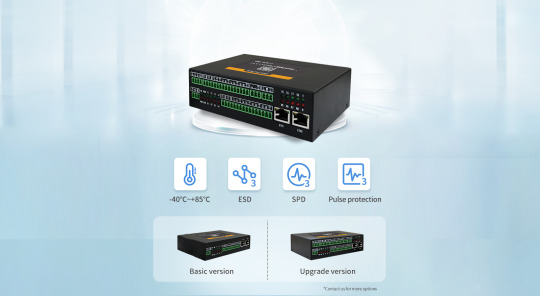
With an industrial-grade design, it can operate stably in harsh environments (-40℃~+85℃) and provides various wireless communication solutions. Its low power consumption and super capacitor solution ensure data backup.
Learn More:
1 note
·
View note
Text
8-Channel Indoor LoRaWAN Gateway with SX1302 for Seamless Sensor Integration
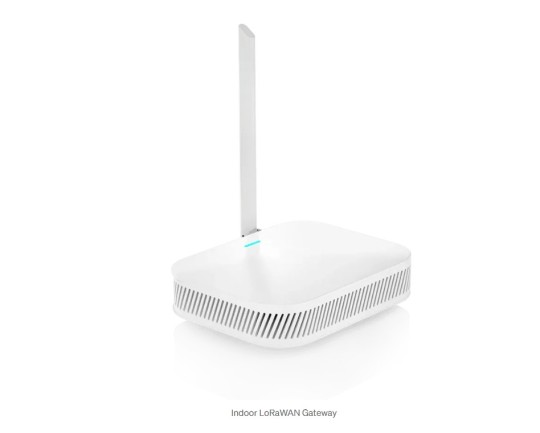
Lansitec Indoor LoRaWAN Gateway based on SX1302 is an ideal product for indoor deployment with its built-in Ethernet connectivity fora straightforward setup. An indoor LoRaWAN gateway is a network device designed to receive and transmit LoRa signals from end devices, forwarding them to a cloud-based network server. At the heart of a successful LoRaWAN network is a commercial LoRaWAN gateway, especially an Indoor LoRaWAN Gateway that serves as a bridge between IoT devices and cloud platforms.
For More:
#Indoor LoRaWAN Gateway#8-Channel Indoor LoRaWAN Gateway#iot#lansitec#lora#bluetooth#technology#wireless#gps#lorawan
0 notes
Text
Data Security and Precision Control: Precision Application of Smart Irrigation Using LoRa Technology and LoRaWAN Gateway
The application characteristics of LoRa modules in smart irrigation technology are mainly reflected in the following aspects:
Low Power Consumption: LoRa modules are characterized by extremely low power consumption, enabling devices to operate for extended periods on battery power. This reduces the hassle of frequent battery replacements and enhances the system's lifespan and reliability.
Anti-Interference Capability: LoRa technology has excellent anti-interference capabilities., ensuring stable communication quality even in environments with multiple radio signals.
Long-Distance Transmission: Utilizing low-frequency transmission, spread spectrum technology, and high-sensitivity receivers, LoRa modules can achieve wireless communication over distances ranging from several kilometers to over ten kilometers.
MESH Self-Organizing Network: LoRa modules can establish communication connections through self-organizing networks, eliminating the need for complex infrastructure and network wiring.
Precision Irrigation: LoRa modules offer stable and accurate data transmission, enabling real-time delivery of information such as soil moisture and weather conditions.
High Penetration: LoRa technology boasts strong signal penetration and stability, ensuring reliable signal transmission even in complex environments.
Multi-Node Support: LoRa modules support applications with multiple nodes. A single LoRa gateway can connect multiple sensor nodes, forming a complete network system for extensive, multi-point monitoring and management.
Data Security: LoRa modules provide high data security, employing encryption technology to protect data during transmission, preventing data theft or tampering, and ensuring the confidentiality and integrity of agricultural data.
Wide Coverage: LoRa technology can achieve wide coverage, typically ranging from several kilometers to over ten kilometers, without the repeaters.
Module Compatibility: LoRa modules are compatible with various types of sensors and control devices, offering a high level of system integration and facilitating seamless cooperation among different devices.

How the LoRa modules achieve precision irrigation in smart irrigation?
Remote Monitoring: Using LoRa modules, the irrigation system can achieve remote monitoring and control. Users can access real-time environmental data such as soil moisture and temperature from a distance and remotely control irrigation equipment, enabling precision irrigation.
Data Analysis: After the cloud platform receives sensor data, it analyzes and processes the information to promptly understand soil moisture conditions, providing a scientific basis for irrigation decisions.
Remote Control of Equipment: LoRa modules transmit commands to various irrigation nodes through long-distance, low-power wireless communication, controlling valve switches, irrigation times, and irrigation amounts.
Timed Irrigation: The irrigation schedule can be preset, and the LoRa module can be used to control the irrigation equipment to irrigate at the best time.
Feedback Mechanism: After irrigation is completed, the system re-monitors soil conditions and feeds the data back to the central control system.
Functions of the LoRaWAN Gateway LG1301-PF in Smart Irrigation Systems
Features of the LG1301-PF Gateway
LG1301-PF is the LoRaWAN gateway. It can work with any LoRaWAN node which comply Standard LoRaWAN protocol V1.0.
The gateway use linux platform as host.It mainly consists of concentrator ,GPS module ,WIFI and Ethernet. The GPS module send NMEA frames containing time and geographical coordinates data to the host. The GPS module also output one pulse to the sx1301 per second.
The gateway receives the RF data from nodes and sends it to the server. It also receive data from the server and transmit to the nodes. The gateway connects to the server via Ethernet or WiFi.
Support for LoRaWAN Protocol: Adapts to the LoRaWAN protocol, enabling the device to communicate with standard LoRaWAN networks for remote data transmission and management.
UART Interface: Provides a UART interface for convenient data exchange and integration with other devices or sensors.
AES128 Encryption: Uses the AES128 encryption algorithm to ensure the security and privacy of data transmission.
8-Channel Simultaneous Communication: Supports up to 8 channels of communication simultaneously
Configurable Parameters: Users can flexibly configure various parameters according to specific application needs.
Global Positioning System Support: GPS functionality enables precise positioning and tracking of the device.
Remote Transmission: Supports remote data transmission, allowing real-time data transfer and management between the device and the cloud via an internet connection.
Frequency Band Support: Covers multiple frequency bands (such as EU433M, EU868M, KR920M, AS923M, CN780M, CN470M, US915M, AS915M, etc.).
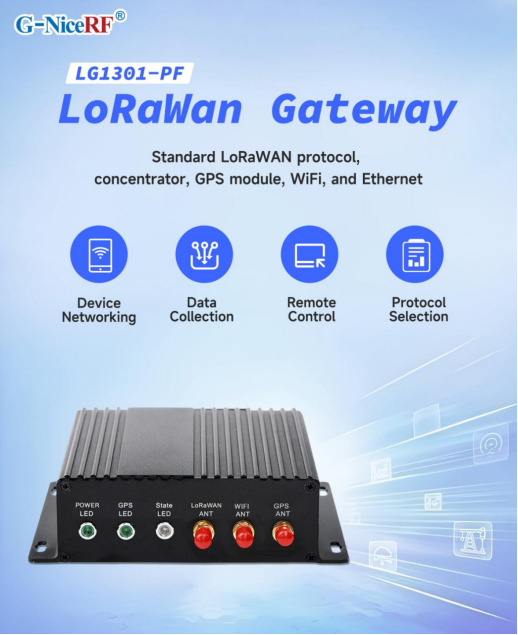
By using NiceRF LoRa gateway devices, sensor equipment in the irrigation field (such as temperature sensors, humidity sensors, light sensors, CO2 sensors, etc.) can be connected in real-time. These sensors collect data in real-time and periodically upload it to the cloud platform or local host computer via LoRa modules. This setup enables remote monitoring, fault alarms, equipment management, and provides scientific and reliable data support for adjusting irrigation strategies.
Data Monitoring Function: The sensor equipment monitors data such as air temperature, air humidity, CO2 levels, light intensity, soil moisture, and soil temperature. This data is transmitted through the LoRa gateway to the cloud platform, allowing users to analyze and process the information conveniently.
Remote Control and Adjustment: The LoRa gateway can connect to irrigation equipment, enabling remote control of the irrigation system. By sending commands from the cloud platform to the LoRa gateway, users can adjust irrigation equipment, such as remotely starting or stopping the equipment or adjusting irrigation parameters. This allows for intelligent irrigation based on feedback from soil moisture sensors, providing precise water management, reducing waste, and improving irrigation efficiency.
Anomaly Alarms and Warnings: The LoRa gateway can monitor abnormal conditions in the farmland environment and send alarm messages to users through the cloud platform. For instance, if soil moisture levels are too low or too high, the LoRa gateway can promptly issue an alert, reminding farmers to take appropriate irrigation measures.
Energy Efficiency Optimization: The gateway is designed with low power consumption features. By optimizing energy management and data transmission frequency, it effectively extends the operating time of the equipment, reduces energy costs, and enhances system sustainability.
For details, please click:https://www.nicerf.com/products/ Or click:https://nicerf.en.alibaba.com/productlist.html?spm=a2700.shop_index.88.4.1fec2b006JKUsd For consultation, please contact NiceRF (Email: [email protected]).
0 notes
Text

MANUFACTURERS OF LORA SCREW MOUNT DUCK TYPE ANTENNA 2023
It seems like you're mentioning a "LoRa screw mount duck type antenna." LoRa stands for "Long Range," and it's a low-power wide-area network (LPWAN) technology designed to enable long-range communication between devices with low data rates. An antenna is a crucial component in any wireless communication system, including LoRa, as it affects the range, signal strength, and overall performance of the network.
A "screw mount duck type antenna" likely refers to an antenna designed for easy installation and mounting using a screw-on mechanism. The term "duck" might refer to the antenna's shape, which can resemble that of a duck's beak or body, though it's not a standardized term. This type of antenna is typically designed for indoor or outdoor use and can be mounted on various devices, such as routers, gateways, or end-node devices, to enhance the wireless communication range and performance.
When selecting an antenna for your LoRa-based application, consider factors such as frequency compatibility (LoRa operates in various frequency bands, such as 433 MHz, 868 MHz, and 915 MHz), gain (which affects the antenna's ability to focus or distribute the signal), and the antenna's physical dimensions and mounting options.
Keep in mind that antenna selection and placement can have a significant impact on the performance of your LoRa network, including range, signal quality, and reliability. It's recommended to consult the documentation provided by your LoRa module or device manufacturer to ensure compatibility and optimal performance when choosing and installing an antenna.
#rf antenna#RF Antenna#celluler antenna#5g antenna#5G Internal Antenna#5G External Antenna#5G Outdoor Antenna#4G LTE Antenna#4G Internal Antenna#4G External Antenna#4G Outdoor Antenna#3G Antenna#3G Internal Antenna#3G External Antenna#3G Outdoor Antenna#2G/GSM Antenna#2G Internal Antenna#2G External Antenna#2G Outdoor Antenna#IoT Lora LPWAN#868MHz Antenna#433MHz Antenna#915MHz Antenna#925MHz Antenna#865MHz Antenna#GPS-GNSS ANTENNA#External GNSS GPS#Magnetic Antenna#Screw Mount Antenna#Adhesive Mount Antenna
0 notes
Text
What is the difference between the LoRaWAN wireless module and LoRa gateway wireless transmission technology?
Many individuals find it challenging to differentiate between the LoRaWAN wireless module and LoRa gateway wireless transmission technology, as well as their applications within the realm of IoT.
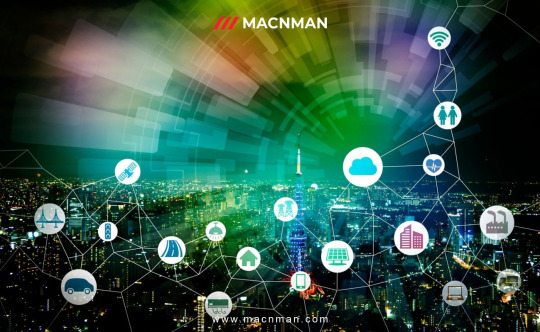
LoRaWAN specifically pertains to the networking protocol found within the MAC (Media Access Control) layer. In contrast, LoRa serves as a protocol within the physical layer. Although current LoRaWAN networking implementations utilize LoRa as the physical layer, it's worth noting that the LoRaWAN protocol also allows for the use of GFSK (Gaussian Frequency-Shift Keying) as the physical layer in specific frequency bands. From a network layering perspective, LoRaWAN can adopt various physical layer protocols, just as LoRa can serve as the physical layer for other networking technologies.
LoRa, as a technology, falls under the category of LPWAN (Low-Power Wide-Area Network) communication technologies. It represents an ultra-long-distance wireless transmission method based on spread spectrum technology, pioneered and promoted by Semtech in the United States. This approach revolutionizes the previous trade-off between transmission distance and power consumption, offering users a straightforward system capable of achieving extended range, prolonged battery life, and increased capacity. Consequently, it expands the capabilities of sensor networks. Currently, LoRa predominantly operates within free frequency bands globally, including 433/868/915MHz, among others.
On the other hand, LoRaWAN wireless communication stands as an open standard defining the communication protocol for LPWAN technology based on LoRa chips. LoRaWAN defines the Media Access Control (MAC) layer at the data link level and is overseen by the LoRa Alliance. It's crucial to distinguish between LoRa and LoRaWAN because companies like Link Labs utilize a proprietary MAC layer in conjunction with LoRa chips to create more advanced hybrid designs, such as Link Labs' Symphony Link.
LoRaWAN typically employs a star or star-to-star topology, which is generally considered superior to mesh networks due to advantages such as conserving battery power and extending communication range. In a star topology, messages are relayed to a central server through gateways, and each end node can transmit data to multiple gateways. These gateways then forward the data to the web server, where tasks like redundancy detection, security checks, and message scheduling are executed.
In summary, LoRa encompasses solely the link layer protocol, making it suitable for point-to-point (P2P) communication between nodes. In contrast, LoRaWAN includes the network layer, allowing data to be sent to any base station connected to a cloud platform. By connecting the appropriate antenna to its socket, the LoRaWAN module can operate at different frequencies, offering versatility in its applications.
0 notes
Text
Lierda Science & Technology Group Co.,Ltd. headquarters
Make the IoT world easier
We have established an integrated industrial chain of IoT embedded solutions : electronic components, microcontrollers, sensors, wireless communication, IoT gateways and IoT cloud platforms, to promote the transition and upgrade of traditional industries.
OUR PRODUCTS AND SERVICES:
CHIP
Lierda distributes international and domestic famous product lines such as ST. Cypress.
NXP. Nordic, Decawave, UTC, ROHM.
KDS etc.,to provides one-stop service of the most cost-effective material selection, technical support, stock and delivery for the customers.
MODULE
Lierda has deep background and rich experience in embedded micro-control technology, RF hardware R&D, communication, networking technology, and has mature communication solutions such as 5G, NB-loT, LoRa, Wi-Fi, Wi-SUN, BLE, etc.
M2M
Focusing on the application of IOT system,
Lierda's rich experience in embedded products is used to create smarter and more practical terminal smart products and adapt to multiple domestic and foreign operator platforms.
Comprehensive product range:
Lierda's product line covers the wireless field, providing customers with semiconductor distribution services and cloud pipe-end complete solutions, independent research and development of 5G, RF, LoRa, NB-IoT,
Cat.1, Wi-SUN, Wi-Fi, BLE, ZigBee and other mature and comprehensive wireless technology solutions, launched smart lighting, four-meter collection, smart travel, logistics chasing
Solutions such as tracking and positioning, AI recognition, and IoT basic service cloud platform are applied to many fields such as smart healthcare, automotive electronics, and photovoltaic inverter
Hope to be your valued supplier from China.
CONTACT:
AMINA ZHU
E MAIL: [email protected]
WhatsApp: 008615061516896
https://en.lierda.com/
#IoTembedded
#microcontrollers
#sensors
#wirelesscommunication
#IoTgateways
#IoTcloudplatforms
#embeddedmicro-controltechnology
#RFhardwareR&D
#5Gcommunicationsolution
#NB-loT
#LoRa
#Wi-Fi
#Wi-SUN
#BLE
#IOTsystem
#semiconductordistribution
#cloudpipe-endsolutions
#Cat.1
#Wi-SUN
#ZigBee
#AIrecognition
#IoTbasicservice

#IoTbasicservice#semiconductordistribution#IoTembedded#microcontrollers#sensors#wirelesscommunication#IoTgateways#IoTcloudplatforms#embeddedmicro-controltechnology#RFhardwareR&D#5Gcommunicationsolution#cloudpipe-endsolutions#AIrecognition
1 note
·
View note
Text
Industrial IoT Gateway: Empowering the Future of Industry with Creative Micro Systems
The rise of the Industrial Internet of Things (IIoT) has paved the way for smart factories, connected equipment, and data-driven decision-making across various industries. As businesses seek to harness the power of real-time data, the need for effective, reliable, and secure solutions has never been more crucial. At the heart of this transformation lies the Industrial IoT Gateway, a pivotal technology that connects industrial devices to cloud systems and ensures seamless data flow. Creative Micro Systems is leading the charge in providing advanced Industrial IoT Gateway solutions that unlock the true potential of IIoT.
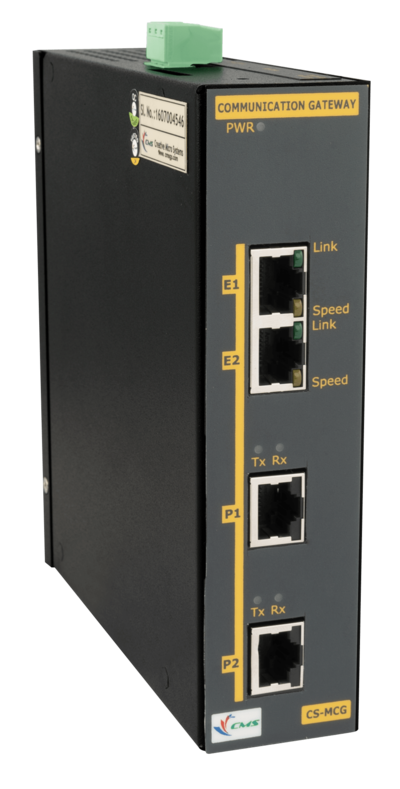
What is an Industrial IoT Gateway?
An Industrial IoT Gateway acts as an intermediary device that connects physical industrial machines and sensors to cloud platforms or enterprise systems. It gathers data from these devices, processes it locally (at the edge), and either sends relevant insights to the cloud for further analysis or makes real-time decisions on-site. Unlike traditional systems, which rely on sending all data to the cloud, IoT gateways enable localized processing, which reduces latency, conserves bandwidth, and ensures faster decision-making.
The gateway serves multiple purposes: it converts data from various industrial protocols into a standardized format, provides a secure connection for data transmission, and ensures real-time processing. This enables manufacturers and industries in sectors like energy, transportation, and agriculture to collect actionable insights from their equipment, leading to improved performance, predictive maintenance, and enhanced operational efficiency.
Creative Micro Systems: Redefining Industrial IoT Gateways
Creative Micro Systems has established itself as a leading provider of Industrial IoT Gateway solutions. The company’s focus is on creating high-performance, secure, and scalable solutions that address the unique demands of industrial environments. Their Industrial IoT Gateways are engineered to support a variety of communication protocols and are designed for rugged, real-time operation in mission-critical applications.
What sets Creative Micro Systems apart from the competition is their commitment to flexibility and reliability. Their gateways are compatible with numerous industrial protocols like Modbus, OPC-UA, MQTT, and REST, making them easily integrable into existing infrastructure. This is crucial for industries looking to modernize without disrupting their current systems.
Moreover, Creative Micro Systems ensures that its Industrial IoT Gateways are built to withstand harsh conditions commonly found in industrial settings, including extreme temperatures, humidity, and vibration. This ruggedness guarantees that the gateway continues to operate under challenging circumstances, ensuring that data collection and analysis remain uninterrupted.
Key Features of Creative Micro Systems' Industrial IoT Gateway
Real-Time Data Processing: The Industrial IoT Gateway by Creative Micro Systems processes data at the edge, reducing latency and ensuring that decision-makers have access to real-time insights. This is especially important for predictive maintenance, where timely intervention can prevent costly equipment breakdowns.
Connectivity Flexibility: Creative Micro Systems' gateways support a wide range of communication protocols, including serial, Ethernet, and wireless (Wi-Fi, LoRa, and 4G/5G). This flexibility makes it easy to integrate a diverse set of industrial devices, regardless of their communication standards.
Enhanced Security: Security is paramount in industrial environments, and Creative Micro Systems places a strong emphasis on data protection. Their gateways feature built-in encryption, secure VPN support, and firewall capabilities to safeguard sensitive data from potential cyber threats.
Scalability: Whether it's a small factory or a global network of industrial plants, Creative Micro Systems' gateways are designed to scale with business needs. Their solutions are adaptable to growing infrastructure, ensuring that companies can expand their IIoT networks without major disruptions.
Low Power Consumption: Industrial IoT devices often operate in remote or energy-sensitive environments. Creative Micro Systems ensures that their gateways are energy-efficient, reducing operational costs while maintaining continuous connectivity.
Cloud Integration: These gateways seamlessly integrate with popular cloud platforms like AWS, Microsoft Azure, and Google Cloud, enabling easy data aggregation, storage, and advanced analytics capabilities.
Why Choose Creative Micro Systems?
Creative Micro Systems stands out as a trusted partner for businesses looking to implement or upgrade their Industrial IoT Gateway solutions. Their products are not only robust and secure but also offer unmatched flexibility, scalability, and real-time data processing capabilities. By providing customized solutions that meet the specific needs of different industries, Creative Micro Systems helps companies unlock the full potential of their IIoT investments.
Benefits of Creative Micro Systems’ Industrial IoT Gateways
Operational Efficiency: Real-time monitoring and predictive analytics allow businesses to detect issues before they escalate, ensuring optimal performance and reducing downtime.
Cost Savings: By improving asset management and reducing the need for constant cloud processing, Creative Micro Systems' gateways contribute to lower operational costs.
Improved Decision-Making: With edge processing and faster access to relevant data, companies can make informed decisions faster, leading to improved overall productivity.
Seamless Integration: Whether modernizing legacy systems or integrating new IoT devices, Creative Micro Systems’ gateways offer plug-and-play compatibility with a wide variety of industrial networks.
Conclusion
In an era where industries are embracing digital transformation, Industrial IoT Gateways are essential for managing and leveraging the massive amounts of data generated by connected devices. Creative Micro Systems is at the forefront of this revolution, providing reliable, secure, and flexible solutions that enable companies to take full advantage of the IIoT. By choosing Creative Micro Systems, businesses can ensure seamless data flow, real-time decision-making, and greater operational efficiency—all critical components for success in today’s competitive industrial environment.
0 notes